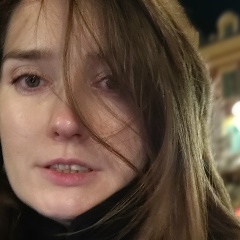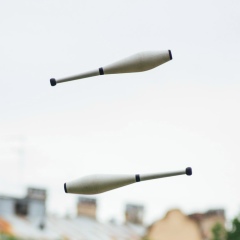Рассказал про эпилепсию человека на французском по теме диссертации.
Короткая история звучит примерно так. У пациентов с эпилепсией височной доли мозга было найдено, что у небольшой группы нейронов отсутствует молекула, которая поддерживает гомеостаз ионов хлора (KCC2, Kation Chloride Cotransporter 2, т. е. хлорно-калиевый ко-транспортер 2 ). Эта молекула относится к целому классу таковых, которые называются Cation Chloride Contransporters (https://en.wikipedia.org/wiki/Cation-chloride_cotrans..). Эти белки занимаются тем, что поддерживают баланс различных ионов внутри и вне клетки. Ко-транспортерами их называют потому, что за один раз они переносят сразу несколько ионов, например, KCC2 переносит ионы калия и хлора. Поскольку заряды этих ионов компенсируют друг друга, такой перенос можно проводить без затрат энергии. Энергия, конечно, используется, но та, которая запасена за счет натрий-калиевой помпы (https://ru.wikipedia.org/wiki/Натрий-калиевая_аденози..). Стоит помнить о том, что баланс именно этих ионов позволяет запускать потенциал действия, чтобы нейроны могли генерировать спайки в принципе (https://ru.wikipedia.org/wiki/Потенциал_действия).
Зачем же нужен KCC2 в нейроне? Дело в том, что баланс хлора крайне важен для того, чтобы торможение было эффективным. Если хлора в нейроне слишком много, это может привести к тому, что тормозные синапсы могут стать возбуждающими. Происходит это потому, что потенциал реверсии (https://en.wikipedia.org/wiki/Reversal_potential) для тормозных GABA синапсов (https://en.wikipedia.org/wiki/GABA_receptor) начинает расти из-за накопления хлора. Это, в свою очередь, приводит к тому, что торможение перестает быть столь эффективным. Если таких клеток в сети может накопиться слишком много, это может привести в росту возбужения за счет реккурентных связей. В норме балланс возбужения-торможеня регулируется, для того, чтобы нейроны могли эффективно обрабатывать информацию (http://www.scholarpedia.org/article/Balance_of_excita..) и генерировать небольшое количество спайков. Существуют теории о том, что именно редкое срабатывание нейронов сети может помогать наиболее оптимально кодировать информацию (http://www.scholarpedia.org/article/Sparse_coding). Но об этом в другой раз, а пока вернемся к эпилепсии.
Как именно именно накопление хлора в сети взаимодействующих нейронов может приводить к эпилепсии было непонятно. Помимо медленного изменения концентрации ионов, нейроны обмениваются нервными импульсами, что тоже меняет концентрацию ионов, как хлора внутри клеток, так и калия снаружи. Для того, чтобы лучше понять механизмы приступа мы построили подробную модель нейронов сети с динамической концентрацией хлора и других ионов. С помощью нее мы показали, что динамика сети может легко стать эпилептической, если есть около 30% клеток, у которых отсутствует KCC2 ко-транспортер. Более того наша, модель оказалась способна воспроизвести активность, записанную в срезах мозга человека, в которых была запущена эпилепсия. Людей мы для этого не резали, но использовали данные, полученные после хирургического удаления очага эпилепсии в гиппокампе (https://ru.wikipedia.org/wiki/Гиппокамп).
Самое приятное для меня, как теоретика, это то, что независимо от нас было найдено, что у мышей с увеличенной экспрессией KCC2 ко-транспортера сложнее вызвать эпилепсию, чем у обычных мышей (https://ep70.eventpilotadmin.com/web/page.php?page=Se..). Что подтверждает нашу идею о том, что отсутствие KCC2 может приводить к приступам.
Помимо этого, мы предсказали, что восстановлении KCC2 может прекратить приступ. Правда это или нет, пока неясно, потому что не совсем понятно как именно можно строго и селективно менять концентрацию хлора в нейронах. Но, будем надеятся, что фармакология и оптогенетика (https://ru.wikipedia.org/wiki/Оптогенетика) помогут когда-нибудь в этом разобраться.
https://www.frm.org/epilepsie-une-proteine-transporteuse-d-ions-mise-en-cause
#нейротоля
Короткая история звучит примерно так. У пациентов с эпилепсией височной доли мозга было найдено, что у небольшой группы нейронов отсутствует молекула, которая поддерживает гомеостаз ионов хлора (KCC2, Kation Chloride Cotransporter 2, т. е. хлорно-калиевый ко-транспортер 2 ). Эта молекула относится к целому классу таковых, которые называются Cation Chloride Contransporters (https://en.wikipedia.org/wiki/Cation-chloride_cotrans..). Эти белки занимаются тем, что поддерживают баланс различных ионов внутри и вне клетки. Ко-транспортерами их называют потому, что за один раз они переносят сразу несколько ионов, например, KCC2 переносит ионы калия и хлора. Поскольку заряды этих ионов компенсируют друг друга, такой перенос можно проводить без затрат энергии. Энергия, конечно, используется, но та, которая запасена за счет натрий-калиевой помпы (https://ru.wikipedia.org/wiki/Натрий-калиевая_аденози..). Стоит помнить о том, что баланс именно этих ионов позволяет запускать потенциал действия, чтобы нейроны могли генерировать спайки в принципе (https://ru.wikipedia.org/wiki/Потенциал_действия).
Зачем же нужен KCC2 в нейроне? Дело в том, что баланс хлора крайне важен для того, чтобы торможение было эффективным. Если хлора в нейроне слишком много, это может привести к тому, что тормозные синапсы могут стать возбуждающими. Происходит это потому, что потенциал реверсии (https://en.wikipedia.org/wiki/Reversal_potential) для тормозных GABA синапсов (https://en.wikipedia.org/wiki/GABA_receptor) начинает расти из-за накопления хлора. Это, в свою очередь, приводит к тому, что торможение перестает быть столь эффективным. Если таких клеток в сети может накопиться слишком много, это может привести в росту возбужения за счет реккурентных связей. В норме балланс возбужения-торможеня регулируется, для того, чтобы нейроны могли эффективно обрабатывать информацию (http://www.scholarpedia.org/article/Balance_of_excita..) и генерировать небольшое количество спайков. Существуют теории о том, что именно редкое срабатывание нейронов сети может помогать наиболее оптимально кодировать информацию (http://www.scholarpedia.org/article/Sparse_coding). Но об этом в другой раз, а пока вернемся к эпилепсии.
Как именно именно накопление хлора в сети взаимодействующих нейронов может приводить к эпилепсии было непонятно. Помимо медленного изменения концентрации ионов, нейроны обмениваются нервными импульсами, что тоже меняет концентрацию ионов, как хлора внутри клеток, так и калия снаружи. Для того, чтобы лучше понять механизмы приступа мы построили подробную модель нейронов сети с динамической концентрацией хлора и других ионов. С помощью нее мы показали, что динамика сети может легко стать эпилептической, если есть около 30% клеток, у которых отсутствует KCC2 ко-транспортер. Более того наша, модель оказалась способна воспроизвести активность, записанную в срезах мозга человека, в которых была запущена эпилепсия. Людей мы для этого не резали, но использовали данные, полученные после хирургического удаления очага эпилепсии в гиппокампе (https://ru.wikipedia.org/wiki/Гиппокамп).
Самое приятное для меня, как теоретика, это то, что независимо от нас было найдено, что у мышей с увеличенной экспрессией KCC2 ко-транспортера сложнее вызвать эпилепсию, чем у обычных мышей (https://ep70.eventpilotadmin.com/web/page.php?page=Se..). Что подтверждает нашу идею о том, что отсутствие KCC2 может приводить к приступам.
Помимо этого, мы предсказали, что восстановлении KCC2 может прекратить приступ. Правда это или нет, пока неясно, потому что не совсем понятно как именно можно строго и селективно менять концентрацию хлора в нейронах. Но, будем надеятся, что фармакология и оптогенетика (https://ru.wikipedia.org/wiki/Оптогенетика) помогут когда-нибудь в этом разобраться.
https://www.frm.org/epilepsie-une-proteine-transporteuse-d-ions-mise-en-cause
#нейротоля
He spoke about human epilepsy in French on the topic of the dissertation.
A short story goes something like this. In patients with epilepsy of the temporal lobe of the brain, it was found that a small group of neurons lacks a molecule that supports homeostasis of chlorine ions (KCC2, Kation Chloride Cotransporter 2, i.e. potassium chloride-co-transporter 2). This molecule belongs to a whole class of those called Cation Chloride Contransporters (https://en.wikipedia.org/wiki/Cation-chloride_cotrans ..). These proteins are committed to maintaining the balance of various ions inside and outside the cell. They are called co-transporters because they transfer several ions at once, for example, KCC2 transfers ions of potassium and chlorine. Since the charges of these ions cancel each other out, such a transfer can be carried out without expenditure of energy. Energy, of course, is used, but the one that is stored at the expense of the sodium-potassium pump (https://ru.wikipedia.org/wiki/Natrium- potassium_denosi ..). It is worth remembering that the balance of precisely these ions allows you to run the action potential so that neurons can generate spikes in principle (https://ru.wikipedia.org/wiki/Action potential).
Why is KCC2 needed in a neuron? The fact is that the balance of chlorine is crucial for braking to be effective. If there is too much chlorine in the neuron, this can lead to the fact that inhibitory synapses can become exciting. This happens because the reversal potential (https://en.wikipedia.org/wiki/Reversal_potential) for inhibitory GABA synapses (https://en.wikipedia.org/wiki/GABA_receptor) begins to increase due to the accumulation of chlorine. This, in turn, leads to the fact that braking ceases to be so effective. If such cells in the network can accumulate too much, this can lead to increased excitation due to recurrent connections. Normally, the excitation-inhibition balance is regulated so that neurons can efficiently process information (http://www.scholarpedia.org/article/Balance_of_excita ..) and generate a small number of spikes. There are theories that it is a rare triggering of network neurons that can help to optimally encode information (http://www.scholarpedia.org/article/Sparse_coding). But more about that another time, but for now let us return to epilepsy.
How exactly the accumulation of chlorine in the network of interacting neurons can lead to epilepsy was not clear. In addition to a slow change in the concentration of ions, neurons exchange nerve impulses, which also changes the concentration of ions, both chlorine inside the cells and potassium outside. In order to better understand the mechanisms of an attack, we built a detailed model of network neurons with a dynamic concentration of chlorine and other ions. Using it, we showed that network dynamics can easily become epileptic if there are about 30% of cells that lack KCC2 co-transporter. Moreover, our model was able to reproduce the activity recorded in sections of the human brain in which epilepsy was started. We did not cut people for this, but used the data obtained after surgical removal of the epilepsy focus in the hippocampus (https://ru.wikipedia.org/wiki/Hippocampus).
The best part for me, as a theoretician, is that, independently of us, it was found that in mice with increased expression of the KCC2 co-transporter it is more difficult to cause epilepsy than in ordinary mice (https://ep70.eventpilotadmin.com/web/page .php? page = Se ..). Which confirms our idea that the absence of KCC2 can lead to seizures.
In addition, we predicted that the recovery of KCC2 could stop the attack. Whether this is true or not is not yet clear, because it is not entirely clear how it is possible to strictly and selectively change the concentration of chlorine in neurons. But, let's hope that pharmacology and optogenetics (https://ru.wikipedia.org/wiki/Optogenetics) will help someday figure this out.
https://www.frm.org/epilepsie-une-proteine-transporteuse-d-ions-mise-en-cause
# neurotol
A short story goes something like this. In patients with epilepsy of the temporal lobe of the brain, it was found that a small group of neurons lacks a molecule that supports homeostasis of chlorine ions (KCC2, Kation Chloride Cotransporter 2, i.e. potassium chloride-co-transporter 2). This molecule belongs to a whole class of those called Cation Chloride Contransporters (https://en.wikipedia.org/wiki/Cation-chloride_cotrans ..). These proteins are committed to maintaining the balance of various ions inside and outside the cell. They are called co-transporters because they transfer several ions at once, for example, KCC2 transfers ions of potassium and chlorine. Since the charges of these ions cancel each other out, such a transfer can be carried out without expenditure of energy. Energy, of course, is used, but the one that is stored at the expense of the sodium-potassium pump (https://ru.wikipedia.org/wiki/Natrium- potassium_denosi ..). It is worth remembering that the balance of precisely these ions allows you to run the action potential so that neurons can generate spikes in principle (https://ru.wikipedia.org/wiki/Action potential).
Why is KCC2 needed in a neuron? The fact is that the balance of chlorine is crucial for braking to be effective. If there is too much chlorine in the neuron, this can lead to the fact that inhibitory synapses can become exciting. This happens because the reversal potential (https://en.wikipedia.org/wiki/Reversal_potential) for inhibitory GABA synapses (https://en.wikipedia.org/wiki/GABA_receptor) begins to increase due to the accumulation of chlorine. This, in turn, leads to the fact that braking ceases to be so effective. If such cells in the network can accumulate too much, this can lead to increased excitation due to recurrent connections. Normally, the excitation-inhibition balance is regulated so that neurons can efficiently process information (http://www.scholarpedia.org/article/Balance_of_excita ..) and generate a small number of spikes. There are theories that it is a rare triggering of network neurons that can help to optimally encode information (http://www.scholarpedia.org/article/Sparse_coding). But more about that another time, but for now let us return to epilepsy.
How exactly the accumulation of chlorine in the network of interacting neurons can lead to epilepsy was not clear. In addition to a slow change in the concentration of ions, neurons exchange nerve impulses, which also changes the concentration of ions, both chlorine inside the cells and potassium outside. In order to better understand the mechanisms of an attack, we built a detailed model of network neurons with a dynamic concentration of chlorine and other ions. Using it, we showed that network dynamics can easily become epileptic if there are about 30% of cells that lack KCC2 co-transporter. Moreover, our model was able to reproduce the activity recorded in sections of the human brain in which epilepsy was started. We did not cut people for this, but used the data obtained after surgical removal of the epilepsy focus in the hippocampus (https://ru.wikipedia.org/wiki/Hippocampus).
The best part for me, as a theoretician, is that, independently of us, it was found that in mice with increased expression of the KCC2 co-transporter it is more difficult to cause epilepsy than in ordinary mice (https://ep70.eventpilotadmin.com/web/page .php? page = Se ..). Which confirms our idea that the absence of KCC2 can lead to seizures.
In addition, we predicted that the recovery of KCC2 could stop the attack. Whether this is true or not is not yet clear, because it is not entirely clear how it is possible to strictly and selectively change the concentration of chlorine in neurons. But, let's hope that pharmacology and optogenetics (https://ru.wikipedia.org/wiki/Optogenetics) will help someday figure this out.
https://www.frm.org/epilepsie-une-proteine-transporteuse-d-ions-mise-en-cause
# neurotol
У записи 19 лайков,
2 репостов,
1448 просмотров.
2 репостов,
1448 просмотров.
Эту запись оставил(а) на своей стене Анатолий Бучин






































